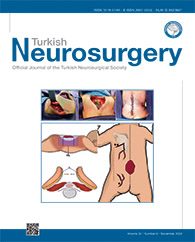2China International Neuroscience Institute (CHINA-INI), Spine Center, Beijing, People?s Republic of China
3Capital Medical University, Beijing Institute of Brain Disorders, Research Center of Spine and Spinal Cord, Beijing, People?s Republic of China
4National Center for Neurological Disorders, Beijing, People?s Republic of China
5Capital Medical University, Xuanwu Hospital, Department of Neurology, Beijing, People?s Republic of China DOI : 10.5137/1019-5149.JTN.35727-21.5 AIM: To include new relevant findings in a systematic review to provide the first comparison of foramen magnum decompression with duraplasty (PFDD) and without duraplasty (PFD) in adult Chiari malformation Type I (CM-I).
MATERIAL and METHODS: We retrospectively searched Web of Science, PubMed, Embase and ClinicalTrials.gov to summarize all relevant published papers on adults. A systemic review was adopted to evaluate clinical or radiological improvement, surgical complications, and reoperation rates between the PFD and PFDD groups.
RESULTS: Nine papers containing information on 497 adult participants met the criteria. PFDD was related to a lower revision rate (RR=2.96, 95% CI: 1.34-6.51, p=0.007) but a higher complication rate (RR=0.35, 95% CI: 0.22-0.55, p<0.00001). No significant difference was noted between PFD and PFDD in terms of overall symptom improvement (RR=0.93, 95% CI: 0.84-1.03, p=0.17) or syringomyelia reduction (RR=0.84, 95% CI: 0.63-1.12, p=0.24). No significant difference in symptom improvement was observed between patients with syringomyelia (RR=0.86, 95% CI: 0.69-1.08, p=0.20) and patients without syringomyelia (RR=0.94, 95% CI: 0.68-1.30, p=0.73).
CONCLUSION: This systematic review of observational studies reveals that PFDD may provide lower revision rates but pose a higher risk than PFD in the management of CM-I in adults. However, PFD is similar to PFDD in clinical and radiological improvements.
Keywords : Chiari malformation Type I; Posterior fossa decompression, Duraplasty, Adult, Meta-analysis




